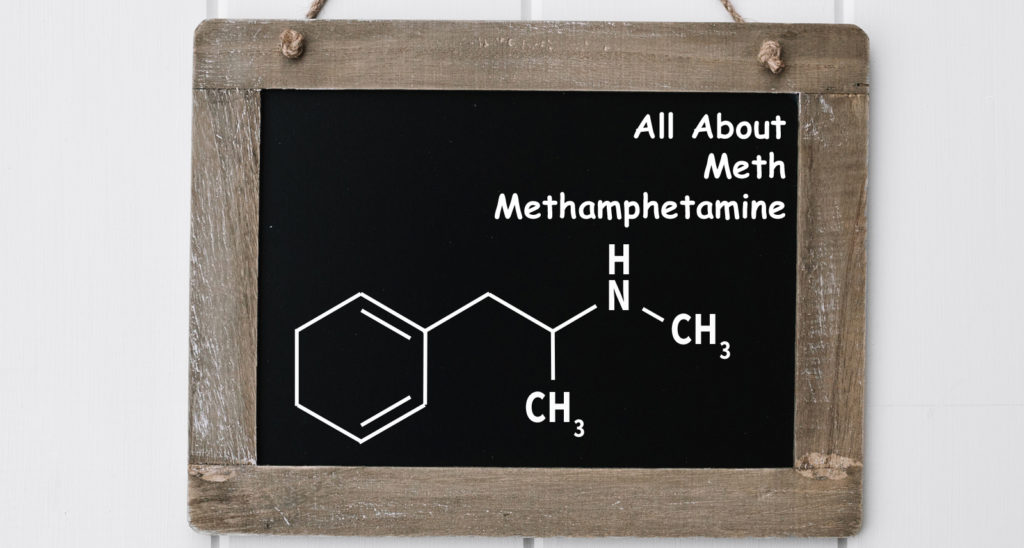Methamphetamine is known by a variety of names, such as crank, ice, and crystal. It comes as a white, bitter-tasting, odorless powder, and this central nervous system stimulant has effects like those of amphetamines. Because of its significant addictive qualities and its severe long-term neurological effects, it is rarely prescribed. Read on to learn more about what is meth and why this illicit drug is so dangerous.
The composition and history of methamphetamine
The chemical composition of meth is n-methyl-1-phenyl-propan-2-amine; it’s often labeled as methyl amphetamine, desoxyephedrine, or methamphetamine. It was first synthesized as amphetamine in 1887; in 1893, it was mixed with ephedrine to make the meth of today. Methamphetamine works by increasing the brain’s production of dopamine, which creates a euphoric feeling that may last for 12 hours or more, depending on the dosage and method of ingestion. When the overwhelming sense of pleasure wears off, strong cravings emerge and typically lead to chronic and habitual use.
How meth is used
According to the federal government, meth is a Schedule II narcotic, which means it’s tightly controlled but not completely banned. When given in a medical setting, prescriptions for methamphetamine are limited to a single fill. Because of its numerous side effects and its addictive qualities, it is rarely prescribed for conditions such as narcolepsy, obesity, and attention deficit hyperactivity disorder. When used as directed, it is taken by mouth, but when used illicitly, it’s injected, snorted, smoked, or dissolved for an immediate effect. Because its euphoric feelings quickly fade, users repeatedly take high doses.
Methamphetamine’s effects on the brain
As stated previously, meth increases the brain’s production of dopamine far beyond natural levels. As a neurotransmitter or chemical messenger, dopamine is like adrenaline; it aids in the control of pleasure and reward centers in the brain. Because the drug encourages the rapid release of dopamine, it produces a nearly instant euphoric rush, as well as an intense desire to dose repeatedly in spite of the risk of addiction.
Signs of meth use
Those who abuse methamphetamine often have a notable lack of self-care, going several days without sleep or food. Long-term meth use has many negative health consequences, including those listed below.
- Rapid and extreme weight loss
- Dental issues such as gum disease and tooth decay (commonly referred to as ‘meth mouth’)
- Skin sores
Users experienced heightened alertness, which leads to insomnia, hyperactivity, diminished appetite, irritability and aggressive behavior, rapid breathing, high heart rate and blood pressure, elevated body temperature, and cardiac arrhythmia.
Long-range effects of methamphetamine abuse
Aside from the high risk of elevated blood pressure, increased heart rate, and overdose, those who use meth for an extended period may experience unrelieved mood swings, inability to sleep, confusion, and anxiety. Some users exhibit signs of psychosis, such as auditory and visual hallucinations, paranoia, and delusions. It’s quite common to experience sensations of insects crawling beneath the skin, leading to intense picking and scratching. There’s an extremely high risk of oral infection and dangerous weight loss. Chronic, prolonged meth use causes molecular and chemical changes in the addict’s brain, altering the dopamine system’s activity, inhibiting verbal learning and diminishing motor skills. In studies done on chronic users, severe functional and structural changes were found in parts of the brain linked to memory and emotion, which may cause cognitive and emotional issues. While some of the above changes may persist after meth use is stopped, some may disappear after an extended period of sobriety. Finally, the use of methamphetamine increases a person’s chances of contracting an infectious disease such as hepatitis B, hepatitis C, or HIV. These diseases may be contracted through unsafe sex or the sharing of tainted needles. Meth reduces inhibition, alters judgement, and makes people more likely to participate in dangerous behaviors.
Symptoms of methamphetamine overdose
The signs of meth overdose and prolonged use are similar, and in many cases, it is hard to determine when a user has overdosed. The most common signs are an elevated heart rate, excessive sweating, rapid pulse, dilated pupils, shortness of breath, and a high body temperature. Heart attacks are quite common with overdose, as are kidney failure and strokes. Such symptoms may take place shortly after the drug is ingested. They may happen too quickly to be seen as an overdose, causing nearly instant death. If someone is showing signs of methamphetamine overdose, call emergency medical services right away.
Combining meth with other drugs
Taking meth with other stimulants such as cocaine may have a devastating outcome. Combining the drug with marijuana, alcohol, heroin, or tobacco increases the risk of overdose, and is extremely toxic with prolonged use.
Detoxification
Withdrawal from methamphetamine comes in two phases. The first phase is acute, and it’s most intense in the 24 hours after the last usage of meth. The protracted phase is less intense, and it lasts approximately two weeks. Common symptoms encountered during the first phase include intense cravings, depression, irritability, agitation, mood swings, paranoia, hallucinations, an inability to focus, fatigue, and body pains. During the second phase, users may deal with cravings, memory problems, depression, and sleep disorders. In some cases, a meth user may experience the symptoms of withdrawal for several months, in what’s known as post-acute withdrawal syndrome or PAWS. Because an addict has typically gone a while without rest, detoxing from methamphetamine may lead to extended periods of sleep.
Testing for meth
Below is information on how long the drug stays in a user’s system and how long it will be detected in testing.
- The plasma half-life of meth is 12-34 hours. After that time, the blood concentration of the drug is reduced by 50%.
- The drug takes two to ten days to leave the user’s body, depending on the level of abuse.
- The effects of use may last anywhere from eight to 24 hours.
- Meth can be detected in urinalysis for up to 72 hours after use.
Depending on the user’s metabolism of the drug, the length of time it remains detectable may vary. However, certain drug tests may be able to detect it for up to 90 days.
The legal status of methamphetamine
As it’s a Schedule II narcotic according to the US government, when it’s not prescribed by a physician, it’s illegal to possess any quantity of methamphetamine. Similar laws are applied in Canada and the United Kingdom.
Overcoming a meth addiction
Overcoming a meth addiction can be challenging. Research indicates that approximately 60% of users use again within one year of treatment. Another 25% relapsed within years two or three. Long-term sobriety is greatly improved with long-term addiction treatment and a plan for ongoing support.

